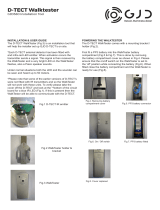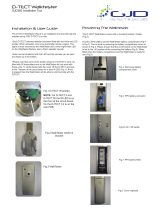Page is loading ...

1
Instruction Manual
DODGE
®
Adapter Mounted
USDAF 23000 Series Pillow Blocks (10-15/16” - 15-3/4”)
USDAF 23100 Series Pillow Blocks (9-7/16” - 14”)
USDAF 23200 Series Pillow Blocks (8-15/16” - 12-1/2”)
These instructions must be read thoroughly before installation or operation.
WARNING: Because of the possible danger to person(s) or property from
accidents which may result from the improper use of products, it is
important that correct procedures be followed: Products must be used
in accordance with the engineering information specified in the catalog.
Proper installation, maintenance and operation procedures must be
observed. The instructions in the instruction manuals must be followed.
Inspections should be made as necessary to assure safe operation under
prevailing conditions. Proper guards and other suitable safety devices or
procedures as may be desirable or as may be specified in safety codes
should be provided, and are neither provided by Baldor Electric Company
nor are the responsibility of Baldor Electric Company. This unit and its
associated equipment must be installed, adjusted and maintained by
qualified personnel who are familiar with the construction and operation
of all equipment in the system and the potential hazards involved. When
risk to persons or property may be involved, a fail safe device must be an
integral part of the driven equipment beyond the speed reducer output
shaft.
GENERAL INFORMATION
DODGE USDAF bearings conform with all appropriate ABMA
standards. They are available in adapter mounting style for
8-15/16” through 15-3/4”. Seals available are TRIPLE-TECT, LER
and Auxiliary Taconite. Complete installation, maintenance and
modication instructions for adapter mounted units are provided
in this manual.
INSPECTION
Inspect shaft. Ensure that the shaft is smooth, straight, clean
and within commercial tolerances. Inspect bearing. Do not allow
bearing to be exposed to any dirt or moisture. Do not remove
slushing compound as it acts as both a protectant and lubricant
and is also compatible with standard greases.
INSTALLATION INSTRUCTIONS
WARNING: To ensure that drive is not unexpectedly started,
turn off and lock out or tag power source before proceeding.
Failure to observe these precautions could result in bodily
injury.
NOTE: Housing caps and bases are not interchangeable; they
must be matched with mating half. Install non-expansion bearing
rst.
1. Apply a coating of light oil or other rust inhibitor to the adapter
area of the shaft.
2. Measure the internal clearance of the bearing before
mounting. Place the bearing in an upright position as shown
in Figure 1. Seat the inner ring and roller elements by pressing
down rmly on the inner ring bore while rotating the inner ring
a few times. Position the roller assemblies so that a roller is
at the top most position on each side. Press these top rollers
inward ensuring contact with center guide ange. Using a
feeler gauge measure the clearance for both sides by inserting
as far as possible and sliding over top of roller (Figure 1). Write
down the measured clearance for use in Step 3d. NOTE: Do
not rotate bearing when moving feeler between roller and
outer ring. Use a sawing motion of feeler to check radial
clearance.
NOTE: If LER seals or Auxiliary Taconite seals are used follow
instruction manual supplied with the seals. TRIPLE-TECT seal
installation is discussed in Step 3.
3. Install the bearing parts in the following sequence: (refer to
parts drawing).
a) V-Ring Seal — Slide one of the V-ring seals onto the shaft,
making sure lip is toward the bearing. NOTE: Do not install
V-ring seal on seal ring until housing cap has been set in place
and tightened.
b) Seal Ring — Install a seal ring on shaft with largest O.D.
toward bearing.
c) Adapter Sleeve — Slide adapter sleeve onto the shaft,
threaded end outboard to the approximate desired location of
the bearing. Apply a coating of light oil to sleeve O.D. Do not
use grease.
d) Bearing — Make sure that the internal clearance has been
written down. Install bearing on adapter sleeve, tapered bore
of bearing to match tapered O.D. of adapter sleeve. Locate
bearing in proper position on shaft.
e) Tighten locknut by hand followed by light tapping on a
bar acting against notches on O.D. of locknut. Using a large
spanner wrench or a hydraulic nut, drive the bearing on the
adapter sleeve until the proper clearance reduction is achieved
(Table 1).
Bolt lockplate to the locknut with the inner prong of the plate
located in the slot of the adapter sleeve. If necessary tighten,
not loosen, locknut to allow prong to t in adapter slot. Use
supplied wire to x lock plate bolts in position and prevent
backing off due to vibration.
f) Seal Ring — Install second V-ring with large O.D. toward
locknut.
g) V-Ring Seal — Slide second V-ring seal onto the shaft,
again, making certain lip is toward bearing. NOTE: Do not
install V-ring seal on seal ring until housing cap has been set in
place and tightened.
Table 1 - Internal Clearance
Shaft Diameter (in.) Reduction in Internal Clearance *(in.)
8-15/16 - 9 .0045 - .0060
9-7/16 - 10-1/2 .0045 - .0065
10-15/16 - 11 .0050 - .0075
11-7/16 - 12-1/2 .0060 - .0085
12-7/16 - 12-1/2 .0065 - .0090
13-15/16 - 13-1/2 .0065 - .0090
15 .0065 - .0090
15-3/4 .0080 - .0105
* Amount of clearance to be removed from clearance measured in
step 2.
Figure 1 - Measurement of
Internal Clearance

2
4. Remove any paint, dirt or burrs from the mating surfaces of the
housing halves. Thoroughly clean seal grooves on both sides.
Set tower half of housing on base and apply oil to the bearing
seats.
5. Apply grease to the bearing and seals. The lubricant should be
smeared between the rolling elements (see Grease Lubrication
section).
6. Place shaft with bearing into lower housing half while carefully
guiding the seal rings into the housing grooves.
7. Bolt lower half of the non-expansion bearing to the base using
grade 8 base bolts. Move shaft endwise so that spacer ring can
be inserted as shown on drawing. Center all other bearings on
same shaft in their housing seats. NOTE: Only one bearing per
shaft is non-expansion, other bearings should be expansion.
8. Shaft extension should not be beyond adapter to ensure no
rubbing with housing on cast closed end.
9. A bead of silicone sealant should be applied between the cap
and the base.
10. Grease the bearing seal grooves in the housing cap and place
over the bearing. The two dowel pins will align the cap with the
lower housing half. NOTE: Each cap must be matched with its
mating lower half, as these parts are not interchangeable.
11. Tighten cap bolts to the recommended torque in Table 2.
12. Assure that there is running clearance at TRIPLE-TECT seal
rings.
13. Misalignment of pillow blocks must not exceed ±1/3 degree.
14. Follow steps 1-13 for the expansion bearing except do not
insert spacer ring. Locate expansion bearing in the center of
the housing.
Table 2 - Recommended Torque Values
Torque
(ft.-lbs.)
Size 1-3/8–6 1-1/2–6 1-3/4–5 2–4-1/2
Grade 2
650 870 1370 2060
Grade 5
1470 1950 2290 3440
15. It is recommended that shear bars be used with these large
bore size pillow blocks.
MAINTENANCE
WARNING: To ensure that drive is not unexpectedly started,
turn off and lock out or tag power source before proceeding.
Failure to observe these precautions could result in bodily
injury. Remove the housing cap in order to inspect bearing
and grease.
GREASE LUBRICATION
USDAF bearings are specically designed for dirty, dusty or
wet environments. In order to properly protect bearings during
installation, pack the bearing insert 100% full immediately after
having properly mounted bearing on the shaft.
If the RPM of the application falls between 20% and 80% of
maximum RPM (Table 5), pack the lower half of the housing one
third to one half full. If the RPM on the application is less than
20% of maximum RPM, pack bearing housing cavity 100% full. If
the RPM exceeds 80% of maximum RPM, do not add grease in
the lower half of the housing nor in the cap.
WARNING: Regreasing requires rotating parts to be exposed.
Exercise extreme care during such operations. Failure to
observe these precautions could result in bodily injury.
At each regreasing cycle, for applications up to 80% of
maximum RPM, slowly add grease until fresh grease is seen
purging at the seals. Regreasing should be done while running.
Remote regreasing lines should be added to avoid endangering
personnel.
If the RPM is greater than 80% of maximum RPM, add 32
strokes of a handgun at each regreasing cycle. For units running
above 80% of maximum RPM, running temperature should be
monitored. If a drastic change in running temperature is noted,
it is recommended to remove the used grease completely and
recharge with fresh grease per the above instructions.
Select a grease with a viscosity at operating temperature which
will provide full lm lubrication (see Table 3). Use a 50°F to100°F
increase in bearing temperature above ambient, depending on
RPM and load. Use Table 4 as a general guide for regreasing
the bearings. A small amount of grease at frequent intervals is
preferable to a large amount of grease at infrequent intervals. For
special applications involving high speeds or high temperatures,
consult Baldor Electric Company, DODGE Engineering,
Greenville, SC.
Table 3 - Viscosity of Oil in the Grease
Δ DN
[Bore Diameter (ins). × RPM]
Viscosity for Average Loads *
(SUS @ Operating Temperature)
100 3500
200 3150
300 2750
400 2375
500 2000
600 1750
700 1500
800 1300
900 1075
1000 900
1400 625
1600 525
1800 450
2000 400
3000 300
4000 200
5000 150
6000 130
7000 110
8000 100
* For loads above 18% of dynamic capacity an EP grease with the above
viscosity is recommended.
Table 4 - Regreasing Intervals (Months)*
(Based on 12 hours per day 150°F max.)
Size
RPM
Up to 250 251-500 501-630
* 8-15/16 - 15-3/4 1 .5 .25
* For continuous operation, 24 hrs/day, decrease greasing interval by 50%.
Table 5 - Maximum RPM
Shaft Size
Maximum RPM - Grease
23000K 23100K 23200K
8-15/16 - 9 – – 700
9-7/16 - 9-1/2 – 670 630
10 - 10-1/2 – 630 600
10-15/16 - 11 630 600 560
11-7/16 - 11-1/2 600 – –
11-15/16 - 12 600 530 530
12-7/16 - 12-1/2 560 500 480
12-15/16 - 13 530 – –
13-7/16 - 13-1/2 530 480 –
13-15/16 - 14 500 450 –
15 450 – –
15-3/4 450 – –

3
LONG-TERM STORAGE OF
PRE-ASSEMBLED BEARINGS
Applications such as conveyor pulleys
and fans are shipped to a job site with
bearings already mounted to the shafts.
Since these units may be stored for long
periods of time in unprotected areas
subject to rain, dust, etc., bearings should
be packed 100% full and so tagged at
bearing assembly to prevent contamination
or corrosion of the bearings. Rotate shaft
at least once a month.
Prior to installation on the structure, if the
application RPM is greater than 20% of
catalog maximum speed, excess grease
must be removed to the levels outlined
previously. Removal of excess grease must
be done in a clean, protected environment.
Table 6 - 23000 Series Replacement Parts
Ref. Name of Part Qty. 10–15/16 11 11–7/16 11–1/2 11–15/16 12 12-7/16 12-1/2 12-15/16 13 13-7/16 13-1/2 13-15/16 14 15 15-3/4
12
4-Bolt Base
(Standard)
1 422580 422580 422502 422502 422529 422529 035183 035183 044164 044164 044165 044165 044166 044166 035417 035943
4-Bolt Base (Cast
Closed)
1 037426 037426 037427 037427 037428 037428 035185 035185 037429 037429 037430 037430 037431 037431 035418 035944
21 Roller Bearing 1 422582 422582 422531 422531 422531 422531 421282 421282 422036 422036 422036 422036 422054 422054 421283 421284
16
Seals
TRIPLE-TECT* 2 047942 047943 047944 047945 047946 047947 047948 047949 047950 047951 047952 047953 047954 047955 047956 047957
LER* 2 042037 422588 042038 042039 042040 422535 046498 046499 042090 042091 042092 042093 042094 042095 050474 047566
Auxiliary* 2 045781 044440 045784 045787 045790 045793 046567 046568 045796 045799 045802 045805 045808 046569 046570 046572
18
Non-Expansion
Spacer
1 422587 422587 422553 422553 422553 422553 422829 422829 042323 042323 042323 042323 042324 042324 422500 422847
20
Adapter Sleeve
Assy (SNP)
1 043581 422576 043582 043583 043584 422525 047632 047635 043635 043636 043637 043638 043639 043640 040830 047638
14 Lubricating Fitting 1 405015 405015 405015 405015 405015 405015 405015 405015 405015 405015 405015 405015 405015 405015 405015 405015
26 Drain Plug 2 430033 430033 430033 430033 430033 430033 430033 430033 430033 430033 430033 430033 430033 430033 430033 430033
* Only two seals per bearing are needed of any one type. For cast closed end blocks, ony one seal per block is needed.
Table 7 - 23100 Series Replacement Parts
Ref. Name of Part Qty. 9-7/16 9-1/2 10-7/16 10-1/2 10-15/16 11 11-15/16 12 12-7/16 12-1/2 13-7/16 13-1/2 13-15/16 14
12 4-Bolt Base (Standard) 1 037461 037461 037432 037432 037434 037434 037436 037436 035945 035945 037438 037438 037440 037440
4-Bolt Base (Cast Closed) 1 037462 037462 037433 037433 037435 037435 037437 037437 035946 035946 037439 037439 037441 037441
21 Roller Bearing 1 421294 421294 421285 421285 421286 421286 421287 421287 052081 052081 421288 421288 421289 421289
16
Seals
TRIPLE-TECT* 2 043538 422545 047940 047941 047942 047943 047946 047947 047948 047949 047952 047953 047954 047955
LER* 2 042510 422594 042036 422573 042037 422588 042040 422535 046498 046499 042092 042093 042094 042095
Auxiliary* 2 040900 040901 045778 042396 045781 044440 045790 045793 046567 046568 045802 045805 045808 046569
18 Non-Expansion Spacer 1 037463 037463 422587 422587 423378 423378 042323 042323 422846 422846 422500 422500 422847 422847
20
Adapter Sleeve Assy (SNP)
1 047630 047631 045431 047637 047638 045464 047639 050531 047641 047642 047643 045434 047644 047645
14 Lubricating Fitting 1 405015 405015 405015 405015 405015 405015 405015 405015 405015 405015 405015 405015 405015 405015
26 Drain Plug 2 430033 430033 430033 430033 430033 430033 430033 430033 430033 430033 430033 430033 430033 430033
* Only two seals per bearing are needed of any one type. For cast closed end blocks, ony one seal per block is needed.
Table 8 - 23200 Series Replacement Parts
Ref. Name of Part Qty. 8-15/16 9 9-7/16 9-1/2 10-7/16 10-1/2 10-15/16 11 11-15/16 12 12-7/16 12-1/2
12 4-Bolt Base (Standard) 1 037464 037464 037442 037442 037444 037444 037447 037447 037449 037449 037451 037451
4-Bolt Base (Cast Closed) 1 037465 037465 037443 037443 037446 037446 037448 037448 037450 037450 037452 037452
21 Roller Bearing 1 422511 422511 421290 421290 421291 421291 421292 421292 422844 422844 421293 421293
16
Seals
TRIPLE-TECT* 2 043571 043572 043538 422545 047940 047941 047942 047943 041946 047947 047948 047949
LER* 2 042544 042545 042510 422594 042036 422573 042037 422588 042040 422535 046498 046499
Auxiliary* 2 040899 040995 040900 040901 045778 042396 045781 044440 045790 045793 046567 046568
18 Non-Expansion Spacer 1 037463 037463 422553 422553 423378 423378 042323 042323 422846 422846 423377 423377
20 Adapter Sleeve Assy (SNP) 1 047628 047629 047646 047647 047648 047649 047678 047679 047680 422843 047681 047682
14 Lubricating Fitting 1 405015 405015 405015 405015 405015 405015 405015 405015 405015 405015 405015 405015
26 Drain Plug 2 430033 430033 430033 430033 430033 430033 430033 430033 430033 430033 430033 430033
* Only two seals per bearing are needed of any one type. For cast closed end blocks, ony one seal per block is needed.
26
16
20 12
21
14 18
HELD
FREE
FIGURE 2 – ADAPTER MOUNT FIGURE 3 – PATENTED
TRIPLE-TECT SEAL

World Headquarters
P.O. Box 2400, Fort Smith, AR 72902-2400 U.S.A., Ph: (1) 479.646.4711, Fax (1) 479.648.5792, International Fax (1) 479.648.5895
Dodge Product Support
6040 Ponders Court, Greenville, SC 29615-4617 U.S.A., Ph: (1) 864.297.4800, Fax: (1) 864.281.2433
www.baldor.com
*3022-0510*
© Baldor Electric Company
MN3022 (Replaces 499808)
All Rights Reserved. Printed in USA.
1/11 PRINTSHOP 100
Table 9 - Cast Dimple Chart for USDAF Housings
Housing
Bearing
Series
“AA”
(in.)
“BB”
(in.)
“CC”
(in.)
“HH”
(in.)
“H”
“II”
(in.)
Hole
Size
(in.)
Bore
Size
(in.)
3248 23248K
6.22 4.34 1.66 30 1-3/4 1-5/8 33
3152
23152K
3252 23252K
6.81 4.63 1.44 33.50 1-3/4 1-5/8 36.25
3156 23156K
3256 23256K
060 23060K
3160 23160K
064 23064K
064L 23064K
068 23068K 6.59 4.25 1.64 34 2 1-7/8 37
3260 23260K
7.17 4.44 1.31 36.50 2 1-7/8 39.75
3164 23164K
072 23072K
072L 23072K
076 23076K
3264 23264K
7.72 5.22 2.00 38.25 2-1/8 2 41.58
3168 23168K
3268 23268K
7.75 5.25 1.50 40.75 2-1/8 2 44
3172 23172K
3176 23176K
080 23080K
084 23084K
Table 10 - Figure 4 Drawing Descriptions
Item Description
A
Optional Seal Grease Location
B
Optional Location for Vent, Vibration Pickup and/or Grease Location for Non W33 Grooved Bearing
C
Position for Thermocouple Location
D
Position for Lubrication of Bearing with W33 Groove
E Lubrication Port for W33 Groove Groove Bearing Drilled Standard on Pillow Blocks
F Pre-drilled and Tapped Location for Vent or Side Lubrication for Bearing without W33 Groove
G
Dowel Pin Location for Metric Plummer Blocks
H Drilling Location for Optional Six-Bolt Mounting or Optional Dowel Pin Location
I Optional Location for Dowel Pin Location
Figure 4 - USDAF Housing Dimensional and Descriptive Drawing
I
E
C
D
B
A
II
HH
CC
BB TYP
AA TYP
DODGE
DODGE
H
F
/




